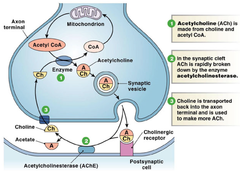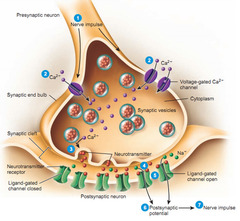Quiz 5- NeuroChemistry – Flashcards
Unlock all answers in this set
Unlock answersquestion
Discovery of chemical messengers
answer
- 1921 - Otto Loewi - acetylcholine and adrenaline (epinephrine) - Frog hearts
question
Accelerates the heartbeat in amphibians
answer
Adrenaline
question
Accelerates the heartbeat in mammals
answer
Noradrenaline (norepinephrine)
question
Acetylcholine

answer
- motor system stimulant - slows heartbeat through release by vagus nerve (atropine blocks ACh)
question
Manufacturing of Neurotransmitters
answer
- Axon terminal from building blocks from food - Cell body according to instructions from DNA - Axon Terminal from mRNA from nucleus
question
4 steps in process of transmitting info across chemical synapse
answer
Transmitter must be... 1. synthesized and stored in axon terminal 2. transported to presynaptic membrane and released in response to action potential 3. interact with the receptors on membrane of target cell located on the other side of the synapse 4. somehow be inactivated or it would continue to work indefinitely
question
Neurotransmitter release

answer
- Presynaptic membrane is rich in voltage-sensitive calcium channels, and the surrounding extracellular fluid is rich in Ca2+. - The action potential opens these voltage-sensitive calcium channels, allowing an influx of calcium ions into the axon terminal. - The incoming Ca2+ binds to a chemical called calmodulin, and does two chemical actions
question
Two things that can happen after Ca2+ binds to calmodulin
answer
- releases vesicles bound to the presynaptic membrane - releases vesicles bound to filaments in the axon terminal.
question
How is the postsynaptic cell affected
answer
The transmitter may... - Depolarize the postsynaptic membrane and so have an excitatory action on the postsynaptic cell - Hyperpolarize the postsynaptic membrane and so have an inhibitory action on the postsynaptic cell - Initiate other chemical reactions.
question
Autoreceptors
answer
- (self-receptors)- presynaptic receptors that a neurotransmitter may activate. - Axon terminal provide feedback to itself
question
What determines excitatory/inhibitory?
answer
The receptor
question
Removal of a neurotransmitter
answer
- Diffuses away from the synaptic cleft and is no longer available to bind to receptors. - Inactivated or degraded by enzymes in the synaptic cleft. - Taken back into the presynaptic axon terminal for subsequent reuse, or the by-products of degradation by enzymes may be taken back into the terminal to be used again in the cell. - The protein molecule that accomplishes this reuptake is a membrane pump called a transporter. - Taken up by neighboring glial cells, which may contain enzymes that degrade transmitters.
question
Type I synapse
answer
- Excitatory - Typically located on dendrites - Round vesicles - Dense material on membranes - Wide cleft - Large active zone
question
Type II Synapse
answer
- Inhibitory - Typically located on cell body - Flat vesicles - Sparse material on membranes - Narrow cleft - Small active zone
question
If a cell is normally inhibited how can an action potential be generated
answer
if the cell body's inhibition is reduced
question
Ionotropic receptors
answer
- allow the movement of ions across a membrane - two parts: (1) a binding site for a neurotransmitter and (2) a pore or channel - Fast response
question
Metabotropic receptor
answer
- lacks its own pore but has a binding site for a neurotransmitter. - produce changes in nearby ion channels or bring changes in the cell's metabolic activity - the receptor is associated with one of a family of proteins called guanyl nucleotide-binding proteins, or G proteins for short - Slow response
question
Acetylcholine
answer
- excitatory effect on skeletal muscles, where it activates an ionotropic receptor, - inhibitory effect on the heart, where it activates a metabotropic receptor.
question
Three groups of transmitters based on their composition
answer
- Small-molecule transmitters - Peptide transmitters (also called neuropeptides) - Transmitter gases
question
Small-molecule transmitters
answer
- synthesized and packaged for use in axon terminals. - can be quickly replaced at the presynaptic membrane. - main components are derived from the food that we eat. - Include: acetylcholine, dopamine, norepinephrine, epinephrine, serotonin, glutamate, GABA, glycine, and histamine
question
Acetylcholine (Ach)
answer
- Involved with the parasympathetic nervous system (slows heart for rest) - Released at neuromuscular junction affecting the skeletal musculature throughout the body - distributed throughout the brain - Affects learning and memory
question
Acetylcholine is made up of what two parts?
answer
choline and acetate
question
Choline
answer
substance obtained from the breakdown of fats, such as egg yolk, and acetate is a compound found in such substances such as vinegar.
question
acetyl coenzyme A (acetyl CoA)
answer
one enzyme that carries acetate to the site where the transmitter is synthesized
question
choline acetyltransferase (ChAT)
answer
second enzyme that transfers acetate to choline to form acetylcholine (ACh).
question
acetylcholinesterase (AChE)
answer
third enzyme that reverses the process of synthesis, detaching acetate from choline.
question
Catecholamines
answer
- Group of 3 different amine NT that contain catechol: Dopamine, Norepinephrine, Epinephrine - Share a catechol nucleus and a common biosynthetic pathway where enzymes are added to shape the raw materials to produce the needed NT - Neurotransmission is similar to processes for other transmitter systems, but they can sometimes be released through the dendrite in a nonexocytotic pattern
question
epinephrine process
answer
see powerpoint
question
Catecholamines
answer
- Widely distributed: - DA- Forebrain, cortical regions, limbic system - Related to ADHD, Parkinson's Disease - NE- Brain stem, influencing the thalamus, hypothalamus, limbic system and cortex - Associated with stress-related disorders, Depression
question
Serotonin (5-HT)
answer
- 5-Hydroxytryptamine - Major neurotransmitter involved in mood, aggression and appetite regulation - Tryptophan - Synthesis - • Reuptake and enzymatic degradation inactivate excess serotonin after discharge and receptor binding - Concentration in cell bodies in brainstem area- raphe nuclei - Send projections to many parts of the brain
question
Tryptophan (Serotonin)
answer
Amino acid from which the neurotransmitter serotonin is derived, the availability of this in the extracellular fluid of neurons regulates the synthesis of serotonin
question
Synthesis (Serotonin)
answer
Tryptophan collected in CNS circulatory systemà transformed into 5-Hydroxytryptophan (5-HTP) by enzyme tryptophan hydroxylase à aromatic amino acid decarboxylase (AADC) metabolizes 5-HTP into 5-HT
question
Influence of Serotonin
answer
- body temperature, respiration, blood pressure, hormone release, uterine activities, attention and arousal, food intake, mood, aggression, nociception and sleep and dreaming
question
5-Hydroxyindole acetic acid (5-HIAA)
answer
Metabolic break-down product of serotonin found in the cerebrospinal fluid, main metabolite of serotonin
question
Amino Acid Transmitters Excitatory amino acid: Glutamate (Glu)
answer
- Principle excitatory neurotransmitter in the brain - Regulates cortical and subcortical functions- cognitive activities - Overexcitation of NMDA receptors leads to neurotoxicity (neural damage due to some threat presented to the nervous tissue such as toxins, low oxygen, decreased glucose, etc.)
question
After release of glutamate, activates receptors
answer
- Ionotropic: Nmethyl-D-aspartate (NMDA), Kainate, Alpha-amino hydroxy-methyl-isoxazolepropionate (AMPA) - Metabotropic: metabotropic-1 and -2
question
Amino Acid Transmitters Inhibitory amino acids
answer
- GABA- principle inhibitory transmitter in the brain - GABA releasedà binds to GABA-A receptorà Cl‾ ion channels openà hyperpolarization of the neuron occursà makes it harder for neuron to fire - GABA that is released and left over is taken up by neighboring neurons and glia - high concentartion in cortex - can regulate seizure activity
question
Formation of GABA
answer
a simple modification of glutamate
question
Glycine (Gly)
answer
Major inhibitory NT for brainstem, spinal cord, and retina



